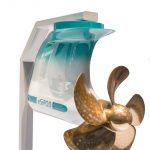Siemens has developed a new eSiPOD. It is supposed to meet the needs of the customers more effectively explains Thorben Kriews, Global Product Manager Podded Drives
In which sectors could the new eSiPOD be used? Have there already been talks with potential customers?
Thorben[ds_preview] Kriews: Electric pod systems are well established in diesel-electric propelled ships, which demand extremely high manoeuverability, efficiency and safety. These are particularly useful for passenger and special vessels, where the configuration of the drive train in the vessel is of great importance. With our pod drive, the
eSiPOD-M, which features a mono-propeller and an increased power range of up to 23MW, we can now meet the needs of our customers even more effectively. These are the individual requirements we are currently working to implement.
What is the competition like within the pod market?
Kriews: The market for pod drives is still a niche market. By developing the eSiPOD further, we have secured a key competitive advantage. In the field of electric pod systems, Siemens is the only provider whose pod drives feature the option of being fitted with double or mono-propellers. Depending on the type of vessel and the driving profile, we adapt the drive units to the individual needs of our customers. In addition to this, our unique space-saving design achieves maximum loading capacity. With our permanent excited electric motors (PEM) we reach unique hydrodynamic advantages.
You have doubtless carried out a potential analysis during the development phase. What were the findings?
Kriews: Results from the technical potential analysis showed that using permanent excited electric motors (PEM) achieves the greatest benefits for the vessel in its entirety. Due to its high efficiency and minimal installation space requirements, PEM technology boasts successes in wind power and mining applications for example. With shipbuilding, it facilitates the option for an ultra-slim pod housing with ideal hydrodynamic properties. This means an overall efficiency increase of up to 5% compared with conventional pod systems. Siemens is the only pod supplier using the PEM technology in an extended power range of up to 23 megawatts.
Why, in your opinion, is the cruise industry in a better position with your new eSiPOD than with previous pod solutions? Kriews: In addition to improved overall efficiency, the eSiPOD features a more simplified and robust design. It is more reliable and reduces maintenance costs. The motor, for example, is cooled almost entirely through the surface of the pod housing, thus reducing the amount of space and energy required. Furthermore, this pod is configured for the new medium-voltage converter platform.
What are the technical specifications of the new model?
Kriews: It is not a new model as such. It is a further development of our previous solution. We have significantly improved the power range with an increase up to 23 MW. We also utilize highly efficient PEM technology for the electric motor within the pod. The slim structure of these motors results in optimal hydrodynamic relationships between the diameter of the gondola and that of the propeller. With eSiPOD-M and eSiPOD-T we now offer mono and twin propellers across the entire power range. Twin propeller systems mean that space requirements beneath the stern are reduced to a minimum. The
eSiPOD-T therefore enables increased flexibility in ship design and maximizes load capacity. This is advantageous for ferries, special-purpose vessels and naval support ships, for example. For vessels which demand high levels of free-running performance and efficiency, such as cruise ships or mega yachts, the eSiPOD-M is the ideal pod system.
What is the advantage of the design having just one propeller?
Kriews: The eSiPOD-M is equipped with an optimized strut whose shape means that vibrations are reduced and fins are obsolete. It also increases course stability while enabling the necessary number of steering movements to be kept to a minimum. The slim propeller hub and streamlined design allowed us to increase hydrodynamic efficiency further.
Recently there have been problems time and again with pods. What did Siemens do in the development stage to reduce the risk of downtimes?
Kriews: A lot has changed as a result of simulation software such as FEM or CFD. Possible risks are identified sooner and can thus be avoided. In addition we regularly conduct research projects with universities and institutes and work closely with our suppliers in order to ensure the highest possible quality standards right from the outset.
Michael Meyer





















